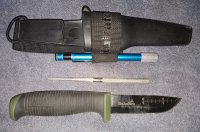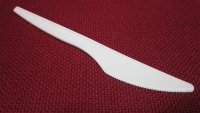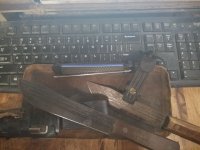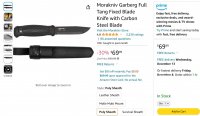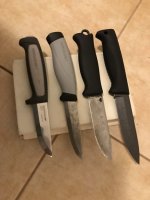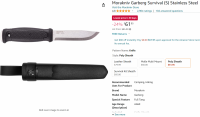OK, Edgar the wannabebushcrafter... My 2 (euro)cents...
Making your own knife is great. But I think you also need a decent production knife of consistent quality to carry into the wild until you are an experienced knifemaker and outdoorsperson.
100 dollars is already a lot of money for a knife. I know some here think you need to spend hundreds to get something good, but most normal people just can't afford that. Many excellent production knives (as opposed to customs or semi-customs) fall in the under-100 bracket. Just to name a few that have already been mentioned here: Cold Steel SRK in SK5 steel, the Terava puukkos, the Peltonen Ranger, BPS, almost every Mora in existence, and many others.
Getting simply a Mora Companion in stainless steel (not the HD, trust me) is a good option. Not the best, but OK. It will do most jobs well enough. But personally I see the budget Moras as either work knives near home or as backups. The more expensive ones are just not the best you can get for that money. The thicker Moras, including the Garberg, have stupid steep grinds that are good for splitting softer woods but either not great or just bad for many other things. Add their C100 (or now 'recycled carbon') steel that goes dull and rusty as soon as you debark one dirty stick with them and let them lay for a ten minute coffee break, and you will not be as happy as you should be for the money to say the least.
I know some people will want to burn me at the stake for saying that... but I have several carbon Moras including a HD which is as thick as the other thicker ones and has the same grind angle, have used them for years and stand by my opinion.
One knife that has not been mentioned in this thread is the Hultafors OK4, or Outdoor Knife. It is part of a series of hard use work knives made by Mora's principal competitor in Sweden, in the same price range. Most of these blades, like the budget Moras btw, are aimed at construction workers, farmers and forestry workers. Of the construction/craftsman series, their GK (Grov Kniven or Rough Knife) is one of the most indestructable knives on the planet. See JoeX on Youtube, who managed to break every knife he tests, stop frustrated at the end after fifty blows with the GK againt his infamous rusty steel pole that breaks every knife that gets that far - with the GK still intact. Hultafors explicitly sells it in packaging explaining you can hit the spine and the pommel with a steel hammer. Construction workers do not use improvised wooden batons to drive a blade through a plank they want to fit, or between two pieces of nailed-together wood to pry them apart. They grab a hammer from their toolbox. Hultafors also makes hammers, shop saws, rulers, prybars, chisels and tool buckets, btw. Basically, if you need to get a thin edge into a narrow space that a steeper edged chisel won't fit into at first, you grab your GK and a hammer of the same brand and drive it in, then wriggle it to make room for bigger prybar tools.
I know because I have done just that, frequently. I have pried nails out of shingle roof with it and rammed it through 22 mm thick OSB to break it apart. That was in 2022; I still use that same blade today and it's in fine condition. It is the ultimate 'prybar that cuts wood really well' - Mors Kochanski would have loved it. And see my review in the review section.
Hultafors makes two outdoor models, both based on the same blade stock as the GK, just nicer finished, black coated and with some laser engraving of an inch/centimeter scale (they invented the folding carpenter's ruler and that engraving commemorates that fact, plus it can sometimes by handy to know how far you have stuck or hammered your blade into something or to make a simple measurement for a craft project. The OK1 has the same huge hardplastic handle as the GK, just of a darker green colour. That's the one you can beat the snot out of the pommel of with a hammer. The OK4 has a slightly shorter handle that is finished with a grooved rubber. Extremely comfortable - it is my most comfortable knife for the kind of cuts and notches in a try stick, and at the same time my favourite picnic knife as it also cuts food really well. It has a finished sharp spine that makes a very good scraper of whatever you want to scrape - firesteel, bark, old paint, a 2x4...
The difference with Moras are 1) steel; 2) profile, 3)tang. The OK4 and other Hulktafors carbon steel blades are made of SK5 Japanese tool steel. Nothing supersteel-ish about that, just a good no-nonsense tool steel that is quite tough, holds a working edge pretty long and does not need black magic and precious stones to sharpen it. It just works. Btw, Hultafors knives are made in Taiwan - which is not communist China - and it is whispered that thay may well come from the same factory that makes the Cold Steel SRK.
The profile is probably more important, given that the steel is just a modest step up from Mora's carbon. Thicker Moras have a 28 degree included grind (14 per side) going down to zero, standard Companions have a 23 degree included grind. It makes the thicker Moras a lor more obtuse so as soon as they get a little bit dull, they go really blunt due to that steep edge angle.
The Hultafors blades all have a 20 degree included grind angle, with a small secondary bevel on the OK series and a larger, stronger secondary on the GK work knife. Meaning they cut a lot better than equivalent Moras. My experience, my opinion. The OK blades are 3 mm thick btw, same as the thicker Moras. Length is 93 mm (just under 4 inches), so they are probably legal in many places where 10 or 12 centimeters is the maximum.
Finally, the tangs. They are more massive that those on Moras, and longer. Not all the way through, as there needs to be a pretty massive chunk of dense plastic at the pommel to hammer on without it splitting around a piece of steel inside. On the pic below the tang ends around where the letter L sits in the word Hultafors. That's under your pinky finger when you hold the knife. You can put a lot of force on that handle.
View attachment 1824222
This is my OK4. Photo this morning. Not a clean new knife. My daily beater at this moment is a GK; I use the OK4 for hikes and to split sticks into small kindling for our wood burner in the livingroom. Can't remember when I last sharpened it. Not sure if it was this year - I have had it since before Covid. I just grabbed a piece of super thin cashier paper, the kind an ATM a machine burps out when you get money. The OK4 sliced it clean. That's typical, it holds its edge really well.
A word on the sheath. Standard Hutafors work knives come in sheaths that are designed to be fitted to a dedicated button on Scandinavian work clothes. Hultafors is part of a group that includes Snickers workwear and they make clothes that have such buttons, most typically at chest level so the knife is ready for use even when you kneel or work in a confined space. One glaring mistake of many reviewers is to mistake the clip on the sheath for a belt clip. It is not, it slips over the said button to stop the sheath from falling off. The OK series however have sheaths with extra nylon belt loops, held in place by that button clip. These also have a firesteel loop (I put a sharpening rod in that, it fits too; three times nothing on Amazon).
A comparison of the OK4 and the OK1 with its fugly oversized handle:
View attachment 1824224
(I bought the OK1 recently for a car emergency kit so it's still clean.)
Now for that 'under 100 dollar' aspect. The OK1 and OK4 costs just a tad over 20 euros in Europe. That's what, under 25 US Dollars? If I'm not mistaken you can get them in Canada through an importer for substantially more. Still not nearly those 100 dollars. Maybe a European knife shop will just send it to the US.
Yep, I am a fan of those. Had I known of them earlier my collection of Moras would be way smaller.
If I were the OP I'd get a midsized 3-layer SAK with a sawblade to accompany it. You'd be able to get most things done. And it will leave a few tenners for a canteen with a cup or whatever.




